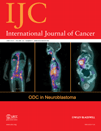Detection of Merkel cell polyomavirus (MCPyV) in Merkel cell carcinoma cell lines: Cell morphology and growth phenotype do not reflect presence of the virus
Fax: +49-40-7410-53250
Abstract
The recently discovered human polyomavirus (MCPyV) is frequently found in Merkel cell carcinoma (MCC) tissue and is believed to be causally linked to MCC pathogenesis. While cell lines established from MCC represent a valuable tool to study the contribution of MCPyV to MCC pathogenesis, hitherto only 1 MCPyV-positive line has been described. We have analyzed 7 MCC cell lines for the presence, integration pattern and copy number of MCPyV. In 5 cell lines, MCPyV specific sequences were detected. In 3 of these lines, multiple copies of viral genomes per cell were detected, and sequencing of PCR amplificates identified distinct mutations predicted to lead to the expression of a truncated large T-Antigen (LT-Ag). In 1 cell line, clonal integration of concatamerized viral genomes was confirmed by Southern Blotting. MCC cell lines are conventionally categorized as “classic” or “variant” and further divided into 4 subtypes, based on expression of neuroendocrine markers and morphology. While it has been suggested that the presence of MCPyV might promote a classic phenotype, such a notion is not supported by our data. Instead, we find MCPyV-positive as well as -negative lines of the classic variety, indicating that the distinguishing features are either inherently independent of viral infection or have become so in the course of tumorigenesis and/or cell line establishment. We therefore suggest a novel classification scheme based on MCPyV presence, integration patterns and T-Ag mutations. The cell lines described here extend the repertoire of available MCPyV-positive MCC-lines and should aid in the elucidation of the role of MCPyV in the pathogenesis of MCC.




